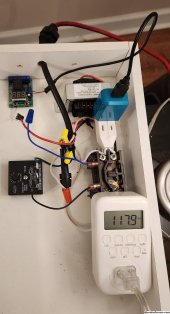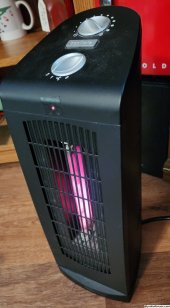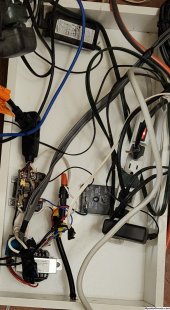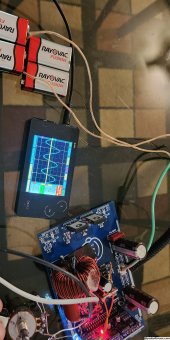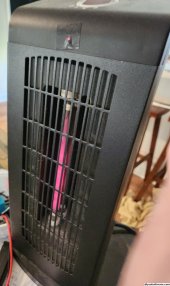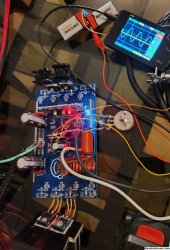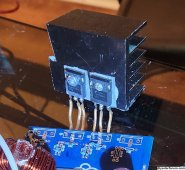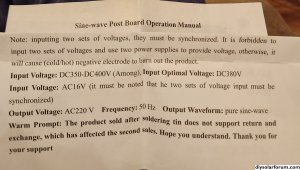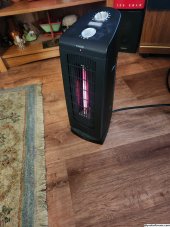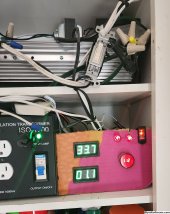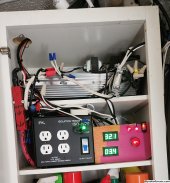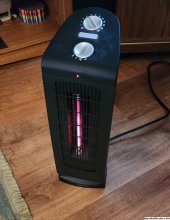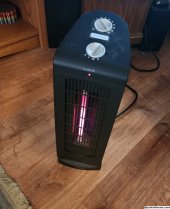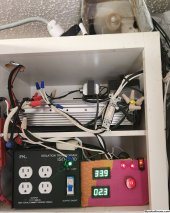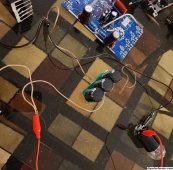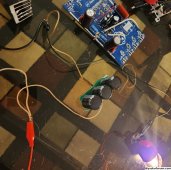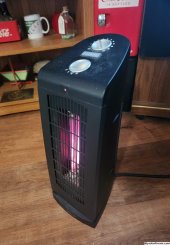GridWorks Green Solar
Solar Innovator
Live testing the Independent down stream load management device 120VAC 15Amp maximum, the top left voltage controlled relay is non functional and will be replaced with a 5VDC DPDT pilot relay powered by a 5VDC USB power adapter shown in green, trigger signal will be from another voltage controlled relay that has worked perfect for months.
Just wanted to show you how easy to build this is, Automatic down stream load management from a green power inverter, only took a couple days to build ?
It is alive and will be running a green power only quartz tube heater in the living room area this coming winter.
Voltage controlled relay load management has changed the way I look at solar PV power, It is not about sky conditions as much as how much you can safely pull from the inverter at any given time.
Drawing is correct but 24VDC needs to be corrected/regulated to voltage controlled relay input power specifications, it is important to use a little of the DC power to properly monitor the system voltage (a charged capacitor voltage will not change if some sort of load is not on the DC power feed), on the one and only working example a standard 25 watt light bulb is the load and is barely glowing the filament.
Please pay attention to what I am telling you, have been in commercial electronics all my life but only in the past two months have I mastered real time inverter protection and downstream load management off a green power inverter and it is all done with a cheap voltage controlled relay, In one basic step you protect the inverter and make a system so automatic you don't have to think about it ?
Seriously worth the effort.
More soon with full power heater testing.Last photo 6.6 amps heater on high down stream more than 130 foot of wire 120VAC
.
Main fuse is in the center of the load manager is 10amp fast blow glass fuse, maximum expected load from the heater is 7amps, system performs wonderfully, with reprogramming the voltage controlled relay set points or the system configuration you can customize the experience for your particular needs.
Best wishes
Just wanted to show you how easy to build this is, Automatic down stream load management from a green power inverter, only took a couple days to build ?
It is alive and will be running a green power only quartz tube heater in the living room area this coming winter.
Voltage controlled relay load management has changed the way I look at solar PV power, It is not about sky conditions as much as how much you can safely pull from the inverter at any given time.
Drawing is correct but 24VDC needs to be corrected/regulated to voltage controlled relay input power specifications, it is important to use a little of the DC power to properly monitor the system voltage (a charged capacitor voltage will not change if some sort of load is not on the DC power feed), on the one and only working example a standard 25 watt light bulb is the load and is barely glowing the filament.
Please pay attention to what I am telling you, have been in commercial electronics all my life but only in the past two months have I mastered real time inverter protection and downstream load management off a green power inverter and it is all done with a cheap voltage controlled relay, In one basic step you protect the inverter and make a system so automatic you don't have to think about it ?
Seriously worth the effort.
More soon with full power heater testing.Last photo 6.6 amps heater on high down stream more than 130 foot of wire 120VAC
.
Main fuse is in the center of the load manager is 10amp fast blow glass fuse, maximum expected load from the heater is 7amps, system performs wonderfully, with reprogramming the voltage controlled relay set points or the system configuration you can customize the experience for your particular needs.
Best wishes
Attachments
Last edited:



